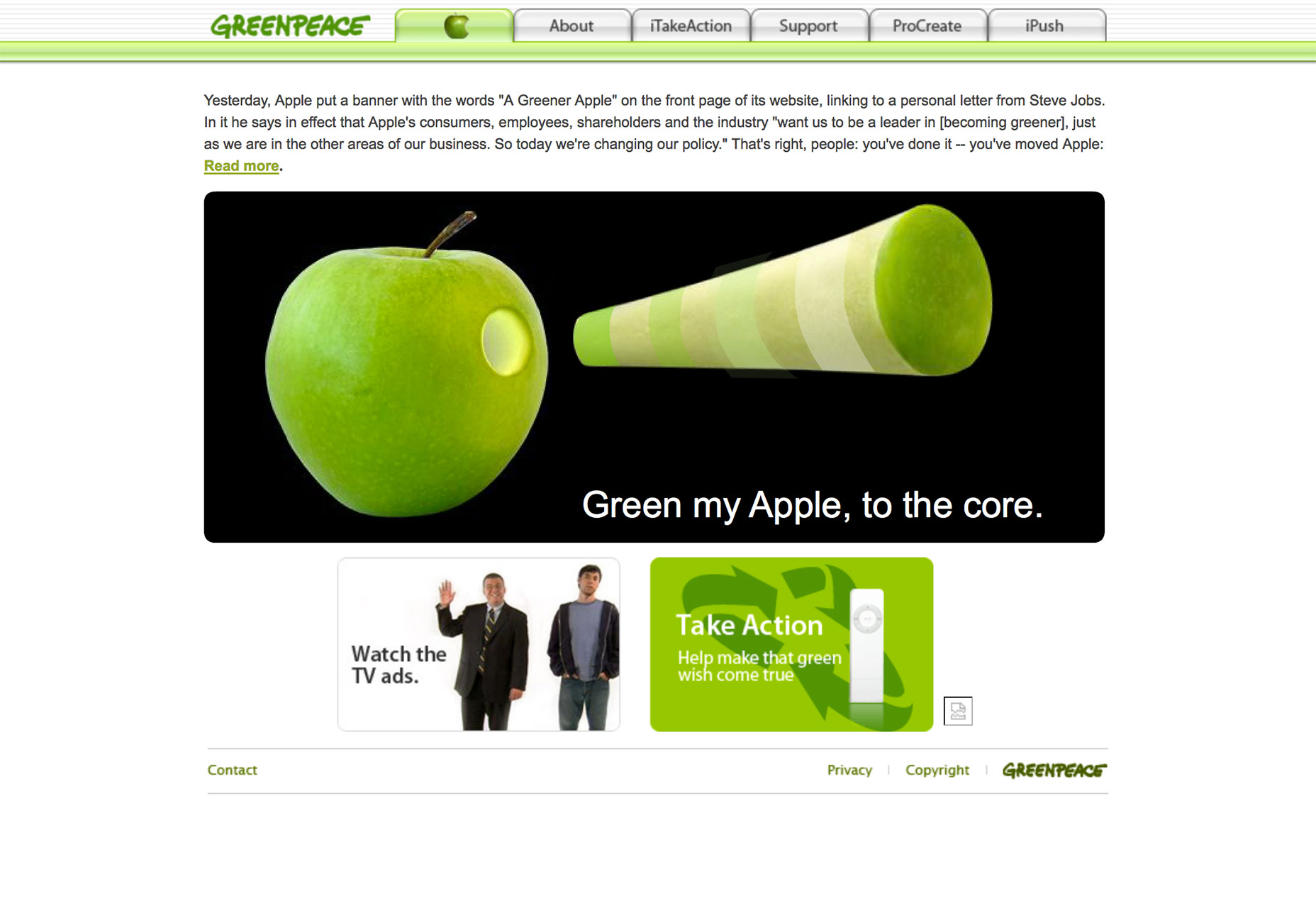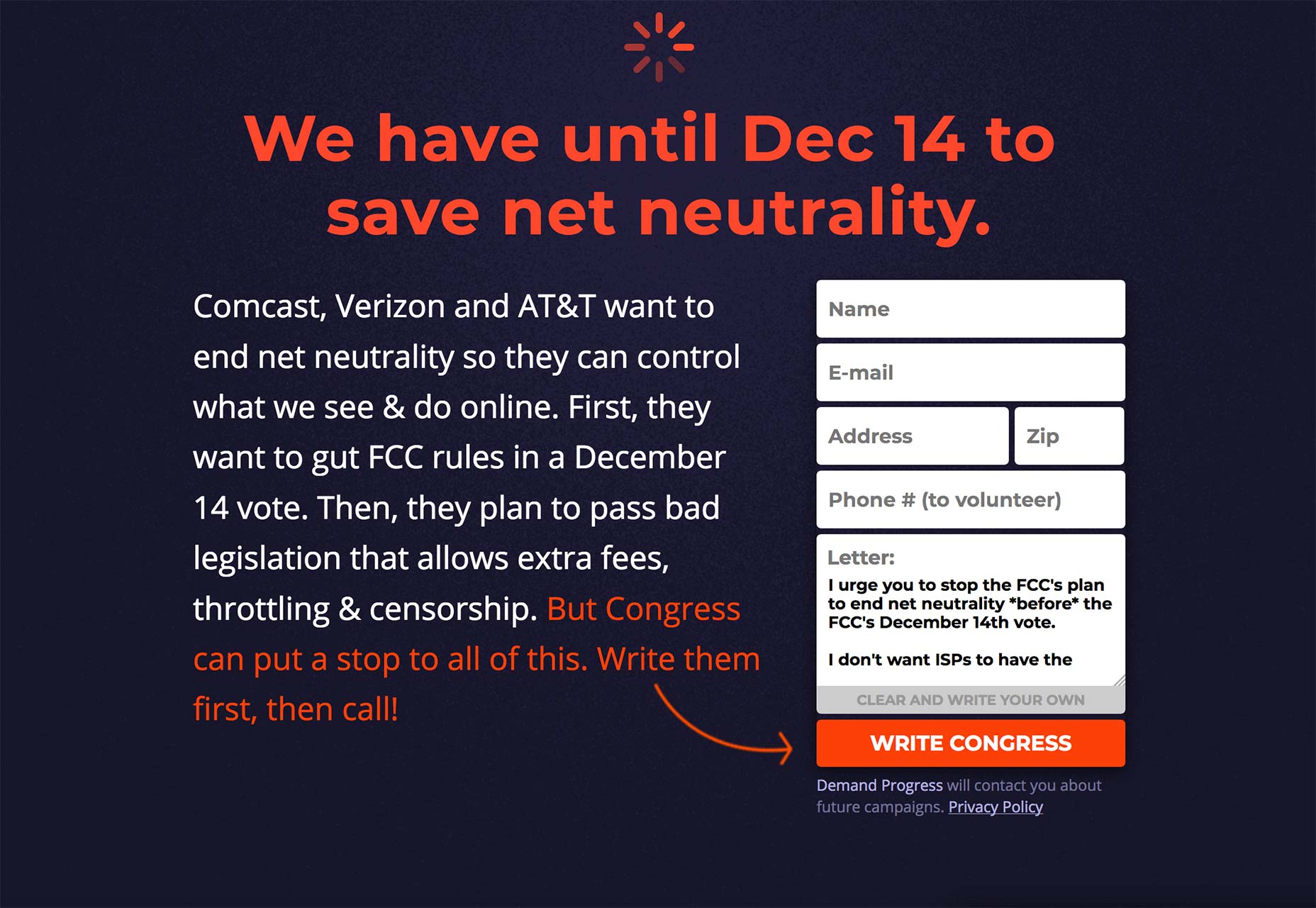
1. Have a Clearly Identified Villain
I don’t mean that you should put a specific individual on blast, as such. That’s how Internet mobs get started. Internet mobs are bad. You want your users to use their anger constructively. The type of Internet justice typically meted out to individuals is often counterproductive at best, and usually just terrifying. But it does help to have a bad guy; and it needs to be clearly named. It’s entirely possible for people to get somewhat angry at no one in particular; but that’s rarely constructive. Your villain can be a fairly vague concept (ignorance), an organization (Comcast or Electronic Arts), a disease, or what-have-you. The point is that you should start pointing fingers.2. Mimicry as Provocation
Tying in with the idea of clearly identifying your villain, you might try mimicry. The best, and most classic example of this is the now-long-gone Green My Apple website which was created by Greenpeace. It was designed to pretty accurately mimic Apple’s website at the time; and it inspired a lot of talk about Apple’s role in environmental pollution. It’s regarded by most as a success story, which you can read on Greenpeace’s website. Heck, it won a Webby award, too. It caught the attention of Apple’s fans because it so obviously looked like Apple’s site. It caught the attention of the web design community because of course it did. We love stories like Green my Apple. It also caught the attention of enough mainstream news sources, and made enough people mad that Apple took notice.
It caught the attention of Apple’s fans because it so obviously looked like Apple’s site. It caught the attention of the web design community because of course it did. We love stories like Green my Apple. It also caught the attention of enough mainstream news sources, and made enough people mad that Apple took notice.
3. Show Your Users How it Affects (or Could Affect) Them
It’s sometimes not enough to just tell users that “Thing X” is bad. In these cases, it’s a good idea to clearly illustrate how “Thing X” is bad for them. And they might need to see it visualized. Battleforthenet.com does this by featuring videos on Net Neutrality by a variety of creators, including: John Oliver, Vimeo (the website), Youtuber Tay Zonday, a few politicians, and more. Other options include infographics, comics, plain old presentations, and plain text. I list plain text last because it only works if people read it all. It is notoriously difficult to get web users to do this, as they tend to skim. [Leave a comment if you read this.]
Other options include infographics, comics, plain old presentations, and plain text. I list plain text last because it only works if people read it all. It is notoriously difficult to get web users to do this, as they tend to skim. [Leave a comment if you read this.]
4. Use Imagery that Shows the Aftermath
When the cause you’re promoting doesn’t directly affect your users, you might try showing them the consequences of inaction. Depending on the subject matter, this may be the nuclear option, as sometimes the consequences can be rather disturbing. Even when we’re not talking about something as violent as war, photos that show the aftermath of bad things can be kind of disturbing. Take for instance the photos on the website Too Young to Wed. When I featured this site a few years ago in an article about designing for non-profits, one user commented on how haunted the girls looked, and how that disturbing that was. In this case, that’s exactly what they were going for. They wanted people to see how sad it was for little girls to be married off to old men. They wanted people to get mad, and do something.
In this case, that’s exactly what they were going for. They wanted people to see how sad it was for little girls to be married off to old men. They wanted people to get mad, and do something.
5. Outline the Win Condition
Okay, now that you’ve made everybody angry, it’s time to be responsible about this. You need to have a specific goal, or a win condition. You can have more than one, with short, medium and long-term goals, but they need to be clearly defined. Undirected rage can result in those mobs I mentioned earlier. The other possible outcomes can be just as bad: Undirected rage can be stifled by simply having nowhere to go. Worse, it might manifest in some unrelated situation, and people could get hurt. Making people mad without clearly defining the circumstances under which they can stop being quite so mad is the path to apathy and/or disaster.Bonus Tip: Make it Easy to Act
Rage doesn’t last long, as a motivation. It’s loud, it’s messy; but people get tired. It’s usually not a long-term motivation. You need to make it very, very easy for them to take one initial step. They just need one small action to make the world a better place. Once they’ve taken that step, you should follow up on them. Turn outrage into determination, and you’ve got a life-long supporter of your cause.Ezequiel Bruni
Ezequiel Bruni is a web/UX designer, blogger, and aspiring photographer living in Mexico. When he’s not up to his finely-chiselled ears in wire-frames and front-end code, or ranting about the same, he indulges in beer, pizza, fantasy novels, and stand-up comedy.
Read Next
15 Best New Fonts, July 2024
Welcome to our monthly roundup of the best fonts we’ve found online in the last four weeks. This month, there are fewer…
By Ben Moss
20 Best New Websites, July 2024
Welcome to July’s round up of websites to inspire you. This month’s collection ranges from the most stripped-back…
Top 7 WordPress Plugins for 2024: Enhance Your Site's Performance
WordPress is a hands-down favorite of website designers and developers. Renowned for its flexibility and ease of use,…
By WDD Staff
Exciting New Tools for Designers, July 2024
Welcome to this July’s collection of tools, gathered from around the web over the past month. We hope you’ll find…
3 Essential Design Trends, July 2024
Add some summer sizzle to your design projects with trendy website elements. Learn what's trending and how to use these…
15 Best New Fonts, June 2024
Welcome to our roundup of the best new fonts we’ve found online in the last month. This month, there are notably fewer…
By Ben Moss
20 Best New Websites, June 2024
Arranging content in an easily accessible way is the backbone of any user-friendly website. A good website will present…
Exciting New Tools for Designers, June 2024
In this month’s roundup of the best tools for web designers and developers, we’ll explore a range of new and noteworthy…
3 Essential Design Trends, June 2024
Summer is off to a fun start with some highly dramatic website design trends showing up in projects. Let's dive in!
15 Best New Fonts, May 2024
In this month’s edition, there are lots of historically-inspired typefaces, more of the growing trend for French…
By Ben Moss
How to Reduce The Carbon Footprint of Your Website
On average, a web page produces 4.61 grams of CO2 for every page view; for whole sites, that amounts to hundreds of KG…
By Simon Sterne
20 Best New Websites, May 2024
Welcome to May’s compilation of the best sites on the web. This month we’re focused on color for younger humans,…














